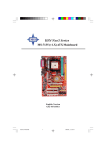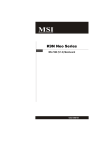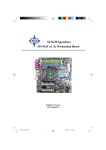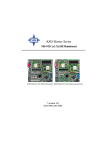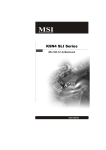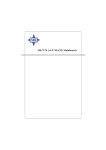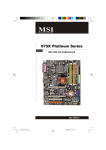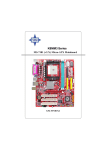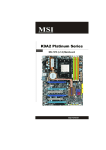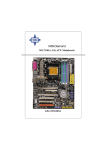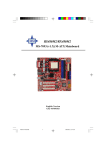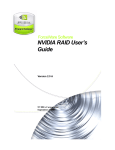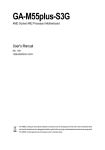Download MSI G52-S9617X1 User's Manual
Transcript
K8T Master2-FAR7 MS-9617 (v1.X) Workstation Board English Version G52-S9617X1 i 9617v1.0-Preface.p65 1 2005/6/14, 下午 05:42 Copyright Notice T he material in this doc ument is the intellec tual property of M ICRO-STAR INTERNATIONAL. We take every care in the preparation of this document, but no guarantee is given as to the correctness of its contents. Our products are under continual improvement and we reserve the right to make changes without notice. Trademarks All trademarks are the properties of their respective owners. AMD, Athlon™, Athlon™ XP, Thoroughbred™, and Duron™ are registered trademarks of AMD Corporation. Intel® and Pentium® are registered trademarks of Intel Corporation. PS/2 and OS ® /2 are registered trademarks of International Business Machines Corporation. W indows ® 95/98/2000/NT/XP are registered trademarks of Microsoft Corporation. Netware® is a registered trademark of Novell, Inc. Award® is a registered trademark of Phoenix Technologies Ltd. AMI® is a registered trademark of American Megatrends Inc. Revision History Revision Revision History Date V1.0 First release June 2005 Technical Support If a problem arises with your system and no solution can be obtained from the user’s manual, please contact your place of purchase or local distributor. Alternatively, please try the following help resources for further guidance. Visit the MSI website for FAQ, technical guide, BIOS updates, driver updates, and other information: http://www.msi.com.tw/program/service/faq/ faq/esc_faq_list.php Contact our technical staff at: [email protected] ii 9617v1.0-Preface.p65 2 2005/6/9, 下午 04:23 Safety Instructions 1. Always read the safety instructions carefully. 2. Keep this User’s Manual for future reference. 3. Keep this equipment away from humidity. 4. Lay this equipment on a reliable flat surface before setting it up. 5. The openings on the enclosure are for air convection hence protects the equipment from overheating. DO NOT COVER THE OPENINGS. 6. Make sure the voltage of the power source and adjust properly 110/220V before connecting the equipment to the power inlet. 7. Place the power cord such a way that people can not step on it. Do not place anything over the power cord. 8. Always Unplug the Power Cord before inserting any add-on card or module. 9. All cautions and warnings on the equipment should be noted. 10. Never pour any liquid into the opening that could damage or cause electrical shock. 11. If any of the following situations arises, get the equipment checked by a service personnel: † † † † The power cord or plug is damaged. Liquid has penetrated into the equipment. The equipment has been exposed to moisture. The equipment has not work well or you can not get it work according to User’s Manual. † The equipment has dropped and damaged. † The equipment has obvious sign of breakage. 12. DO NOT LEAVE THIS EQUIPMENT IN AN ENVIRONMENT UNCONDITIONED, STORAGE TEMPERATURE ABOVE 600 C (1400F), IT MAY DAMAGE THE EQUIPMENT. CAUT ION: Danger of expl os i on if bat ter y i s i nc orrec tl y r epl ac ed. Replac e only with the same or equivalent type rec ommended by the manufacturer. iii 9617v1.0-Preface.p65 3 2005/6/9, 下午 04:23 FCC-B Radio Frequency Interference Statement T h is eq uip men t h as been tested and found to c omply with the limits for a Class B digital device, pursuant to Part 15 of the FCC Rules. These limits are designed to provide reasonable protection against harmful interference in a residential installation. This equipment generates, uses and can radiate radio frequency energy and, if not installed and used in accordance with the instructions, may cause harmful interference to radio communications. However, there is no guarantee that interference will not occur in a particular installation. If this equipment does cause harmful interference to radio or television reception, which can be determined by turning the equipment off and on, the user is encouraged to try to correct the interference by one or more of the measures listed below. † Reorient or relocate the receiving antenna. † Increase the separation between the equipment and receiver. † Connect the equipment into an outlet on a circuit different from that to which the receiver is connected. † Consult the dealer or an experienced radio/television technician for help. Notice 1 The changes or modifications not expressly approved by the party responsible for compliance could void the user’s authority to operate the equipment. Notice 2 Shielded interface cables and A.C. power cord, if any, must be used in order to comply with the emission limits. VOIR LA NOTICE D’INSTALLATION AVANT DE RACCORDER AU RESEAU. Micro-Star International MS-9617 This device complies with Part 15 of the FCC Rules. Operation is subject to the following two conditions: (1) this device may not cause harmful interference, and (2) this device must accept any interference received, including interference that may cause undesired operation. iv 9617v1.0-Preface.p65 4 2005/6/9, 下午 04:23 WEEE (Waste Electrical and Electronic Equipment) Statement v 9617v1.0-Preface.p65 5 2005/6/9, 下午 04:23 vi 9617v1.0-Preface.p65 6 2005/6/9, 下午 04:23 vii 9617v1.0-Preface.p65 7 2005/6/9, 下午 04:23 CONTENTS Copyright Notice .............................................................................................................. ii Trademarks ....................................................................................................................... ii Revision History .............................................................................................................. ii Technical Support ........................................................................................................... ii Safety Instructions .......................................................................................................... iii FCC-B Radio Frequency Interference Statement ........................................................ iv W EEE (Waste Electrical and Electronic Equipment) Statement .................................... v Chapter 1. Getting Started .................................................................................... 1-1 Mainboard Specifications ................................................................................... 1-2 Mainboard Layout ................................................................................................ 1-4 MSI Special Features .......................................................................................... 1-5 Core Center .................................................................................................. 1-5 Chapter 2. Hardware Setup .................................................................................. 2-1 Quick Components Guide .................................................................................... 2-2 Central Processing Unit: CPU ............................................................................. 2-3 CPU Installation Procedures for Socket 940 ............................................. 2-4 Installing AMD OpteronTM CPU Cooling System ........................................ 2-5 Memory ................................................................................................................. 2-7 Installing DDR Modules ................................................................................ 2-7 Memory Population Rules ............................................................................ 2-8 Power Supply ...................................................................................................... 2-9 SSI 4-Pin VGA Power Connector: JPWR2 (Optional) ............................... 2-9 SSI 8-Pin CPU Power Connector: JPWR1 .................................................. 2-9 SSI 24-Pin System Power Connector: JPR1 ........................................... 2-10 Back Panel ........................................................................................................... 2-11 Mouse Connector (Green) / Keyboard Connector (Purple) ................... 2-11 Serial Ports ................................................................................................. 2-12 USB Connectors ........................................................................................ 2-12 RJ-45 LAN Jack .......................................................................................... 2-13 Audio Port Connectors .............................................................................. 2-13 Parallel Port Connector: LPT1 ................................................................... 2-14 Connectors ........................................................................................................ 2-15 Floppy Disk Drive Connector: FDD1 .......................................................... 2-15 Hard Disk Connectors: IDE1, IDE2 ............................................................ 2-15 Serial ATA/Serial ATA RAID Connectors: SATA1, SATA2 ....................... 2-16 SCSI LED Connector: J7 ............................................................................ 2-17 viii 9617v1.0-Preface.p65 8 2005/6/14, 下午 05:46 Fan Power Connectors: CFAN1/2, SFAN1, NBFAN1 .............................. 2-17 IrDA Infrared Module Header: JIR1 ........................................................... 2-18 Front Panel Audio Connector: JAUD1 ...................................................... 2-18 Chassis Intrusion Switch Connector: JCI1 .............................................. 2-19 CD-In Connector: JCD1 ............................................................................. 2-19 Front Panel Connectors: JFP1, JFP2 ....................................................... 2-19 D-Bracket™ 2 Connector: JLED ............................................................... 2-20 Front USB Connectors: JUSB1, JUSB2 ................................................... 2-22 Jumper ................................................................................................................ 2-23 Clear CMOS Jumper: JBAT1 ..................................................................... 2-23 Slots .................................................................................................................... 2-24 AGP (Accelerated Graphics Port) Pro Slot .............................................. 2-24 PCI (Peripheral Component Interconnect) Slots ...................................... 2-24 PCI Interrupt Request Routing ................................................................... 2-24 Chapter 3. BIOS Setup ............................................................................................ 3-1 Entering Setup ..................................................................................................... 3-2 Control Keys ................................................................................................ 3-2 Getting Help .................................................................................................. 3-3 The Main Menu ..................................................................................................... 3-4 Standard CMOS Features ................................................................................... 3-6 Advanced BIOS Features ................................................................................... 3-8 Advanced Chipset Features ............................................................................ 3-10 Integrated Peripherals ....................................................................................... 3-14 Power Management Setup ............................................................................... 3-19 PC Health Status ................................................................................................ 3-22 Frequency/Voltage Control ............................................................................... 3-24 Load Fail-Safe/Optimized Defaults .................................................................. 3-25 Set Supervisor/User Password ....................................................................... 3-26 Appendix A: VIA VT8237R SATA RAID ................................................................. A-1 Introduction .......................................................................................................... A-2 BIOS Configuration .............................................................................................. A-3 Installing RAID Software & Drivers .................................................................. A-10 Using VIA RAID Tool .......................................................................................... A-13 Appendix B: Using 2-, 4-, 6- or 8- Channel Audio Function .......................... B-1 Installing the Audio Driver ................................................................................... B-2 Installation for W indows 98SE/ME/2000/XP .............................................. B-2 ix 9617v1.0-Preface.p65 9 2005/6/14, 下午 05:46 Software Configuration ...................................................................................... B-4 Sound Effect ................................................................................................ B-5 Speaker Configuration ................................................................................ B-7 3D Audio Demo ............................................................................................. B-9 General ....................................................................................................... B-10 SPDIF .......................................................................................................... B-11 Microphone Effect ..................................................................................... B-12 Using 2-, 4-, 6- & 8- Channel Audio Function ................................................. B-13 x 9617v1.0-Preface.p65 10 2005/6/14, 下午 05:46 Getting Started Cha pter 1 . Getting Started Getting Started Thank you for choosing the K8T Master2-FAR7 (MS-9617 v1.x), an excellent ATX workstation board from MSI. Based on the innovative VIA® K8T800 Pro and VIA® VT8237R chipsets for optimal system efficiency, the K8T Master2-FAR7 mainboard accommodates dual latest AMD Opteron DPTM/UPTM processors in the 940-pin lidded ceramic micro PGA package, and supports up to four 144-bit DDR registered ECC DIMMs (at 200, 266, 333 and 400MHz) to provide the maximum of 8 GB memory capacity. This mainboard provides a cost-effective and professional solution for high-end workstation and server markets. 1-1 9617v1.0-1.p65 1 2005/6/9, 下午 04:26 MS-9617 ATX Workstation Board Mainboard Specifications CPU † Supports dual Socket 940 for AMD OpteronTM processors, from 1.4 ~ 3.6 GHz (For more information on compatible components, please visit http://www.msi. com.tw/program/products/server/svr/pro_svr_qvl.php) Chipset † VIA® K8T800 Pro Northbridge - HyperTransport link to the AMD OpteronTM CPU - 800/600/400/200 MHz “Double Data Rate” operation both direction - AGP v3.0 compliant with 8X transfer mode † VIA® VT8237R Southbridge - Integrated Hardware Sound Blaster/Direct Sound AC97 audio - Ultra DMA 66/100/133 master mode PCI EIDE controller - Supports Serial ATA RAID - Supports eight high-speed USB 2.0 ports at up to 480Mb/s transfer - Extensive ACPI-compliant power management - Integrated Faster Ethernet LPC M ain M emory † 144-bit DDR at 200/266/333/400 MHz † Supports four 184-pin DDR DIMMs up to 8GB † Supports interleaving memory within DIMMs † ChipKill ECC allows continuous correction of 4-bit errors in a failed x 4 memory device (For more information on compatible components, please visit http://www.msi. com.tw/program/products/server/svr/pro_svr_qvl.php) Slots † One AGP Pro 8x/4x slot. † Four 32-bit/33 MHz PCI slots HDD Interface † An IDE controller on the VT8237R chipset - Provides IDE HDD/CD-ROM with PIO, Bus Master and Ultra DMA 133/100/66 operation modes - Can connect up to 4 IDE devices † Serial ATA/150 controller integrated in VT8237R - Up to 150MB/sec transfer rate - Can connect up to two Serial ATA drives Onboard Peripherals † 2 x IDE ports † 1 x PS/2 keyboard port and 1 x PS/2 mouse port † 2 x serial ports † 1 x parallel port supports SPP/EPP/ECP mode 1-2 9617v1.0-1.p65 2 2005/6/9, 下午 04:26 Getting Started † 1 x RJ-45 port (with LEDs) † 8 x USB ports (front*4 and rear*4) † 2 x SATA ports Networking † Broadcom BCM5705 Gigabit Ethernet controller Audio † AC’97 link controller integrated in VIA VT8237R † 8-channel audio codec Realtek ALC850 - Compliance with AC97 v2.3 Spec - Meets PC2001 audio performance requirement Power M anagement Features † W ake up on LAN (W OL), wake up on PCI † RTC alarm and wake up † W ake up on keyboard/mouse/USB from S1 † Supports ACPI S1, S4, S5 function Sy stem M anagement † SMBus (I2C) † Temperature, voltage, and fan monitors † Chassis intrusion BIOS † The mainboard BIOS provides “Plug & Play” BIOS which detects the peripheral devices and expansion cards of the board automatically † The mainboard provides a Desktop Management Interface (DMI) function which records your mainboard specifications † Supports boot from LAN, USB Device 1.1 & 2.0, and SATA HDD Dimension † ATX Form Factor: 12.0 x 10.0 inch (H x W ) M ounting † 9 mounting holes (ATX Form standard) MSI Reminds You... To create a bootable RAID volume for a Windows 2000 environment, Microsoft’s Windows 2000 Service Pack 4 (SP4) is required. As the end user cannot boot without SP4, a combination installation CD must be created before attempting to install the operating system onto the bootable RAID volume. To create the combination installation CD, please refer to the following website: http://www.microsoft.com/windows2000/downloads/servicepacks/ sp4/HFdeploy.htm 1-3 9617v1.0-1.p65 3 2005/6/9, 下午 04:26 MS-9617 ATX Workstation Board D DR 4 D DR 3 JPR 1 D DR 2 Top: Mouse Bottom : Keyboard D DR 1 Mainboard Layout CFAN1 Top : Parallel Port Bottom: C OM A C OM B C FAN 2 Top: SPD IF O ut Bottom: U S B Ports T: Line-In M: Line-Out B: Mic T: R S-O ut M : CS-Out B: SPDIFO ut NBFAN 1 JPW R1 Top: LAN Jack Bottom: U SB Ports A G P1 JPW R2 VIA K8T800 Pro JFP2 PCI1 JFP1 BIOS PCI2 JCI1 W83627 TH F ID E1 PCI3 VIA VT8237R ID E2 J7 PCI4 ALC 850 JC D 1 FDD 1 JAUD1 SATA1 SATA2 JIR 1 JLED JBAT1 SFAN 1 K8T Master2-FAR7 (MS-9617 v1.X) ATX Workstation Board 1-4 9617v1.0-1.p65 4 2005/6/9, 下午 04:26 Getting Started MSI Special Features Core Center The Core Center is a new utility you can find in the CD-ROM disk. The utility is just like your PC doctor that can detect, view and adjust the PC hardware and system status during real time operation. In the left side it shows the current system status, including the Vcore, 3.3V, +5V and 12V. In the right side it shows the current PC hardware status such as the CPU & system temperatures and all fans speeds. W hen you click the red triangles in the left and right sides, two sub-menus will open for users to overclock, overspec or to adjust the thresholds of system to send out the warning messages. If you click the Core Center button on the top, a screen pops up for you to choose the “Auto mode” or “User mode” of CPU fan. You may adjust the speeds of CPU fans and system fan here. 1-5 9617v1.0-1.p65 5 2005/6/9, 下午 04:26 MS-9617 ATX Workstation Board Left-side: Current system status In the left sub-menu, you can configure the settings of FSB, Vcore, Memory Voltage and AGP Voltage by clicking the radio button in front of each item and make it available (the radio button will be lit as yellow when selected), use the “+” and “-” buttons to adjust, then click “ok” to apply the changes. Then you can click Save to save the desired FSB you just configured. Also you may click Auto to start testing the maximal CPU overclocking value, The CPU FSB will automatically increase the testing value until the PC reboots. Or you may click Default to restore the default values. Right-side: PC hardware status during real time operation In the right sub-menu, here you can configure the PC hardware status such as CPU & system temperatures and fan speeds. You may use the scroll bars to adjust each item, then click “ok” to apply the changes. The values you set for the temperatures are the maximum thresholds for the system for warnings, and the value for fan speeds are the minimum thresholds. Top-side: User mode/Auto mode Here you may adjust the CPU fan speed. If you choose User mode, you may adjust the CPU fan speed in 8 different modes, from Stop to Full speed. MSI Reminds You... Items shown on Core Center may vary depending on your system status. 1-6 9617v1.0-1.p65 6 2005/6/9, 下午 04:26 Hardware Setup Chapter 2. Hardware Setup Hardware Setup This chapter provides you with the information about hardware setup procedures. W hile doing the installation, be careful in holding the c omponents and follow the installation procedures . For s ome components, if you install in the wrong orientation, the components will not work properly. Use a grounded wrist strap before handling computer components. Static electricity may damage the components. 2-1 MS-9617 ATX Workstation Board Quick Components Guide CFAN1, p.2-17 JPR1, p.2-10 DDR1~4, p.2-7 CFAN2, p.2-17 I/O Ports, p.2-11 CPU1, p.2-3 CPU2, p.2-3 JPWR1, p.2-9 JPWR2, p.2-9 NBFAN1, p.2-17 AGP1, p.2-24 JUSB1, p.2-22 JUSB2, p.2-22 JFP2, p.2-19 PCI Slots, p.2-24 JFP1, p.2-19 JCI1, p.2-19 IDE1/2, p.2-15 J7, p.2-17 JBAT1, p.2-23 JCD1, p.2-19 FDD1, p.2-15 JAUD1, p.2-18 SATA1/2, p.2-16 JIR1, p.2-18 SFAN1, p.2-17 JLED, p.2-20 2-2 Hardware Setup Central Processing Unit: CPU The mainboard supports dual AMD ® Opteron processors. The mainboard uses two CPU sockets called Socket 940 for easy CPU installation. You can install SINGLE or DUAL CPUs on the mainboard to meet your own needs. Keep the following points in mind before installing CPU(s). 1. If SINGLE CPU is intended, always install the CPU on the CPU1 socket. CPU1 CPU2 2. To install DUAL CPUs on the board, you must use the same type of CPUs running at the same frequency. W hen you are installing the CPU, make sure the CPU has a Heat Sink and a cooling fan attached on the top to prevent overheating. If you do not find the Heat Sink and cooling fan, contact your dealer to purchase and install them before turning on the computer. For more information on compatible components, please visit http://www.msi.com. tw/program/products/server/svr/pro_svr_qvl.php . MSI Reminds You... Overheating will seriously damage the CPU and system, always make sure the cooling fan c an work properly to protec t the CPU from overheating. The system temperature needs to remain under 45°C. We highly recommend that the direction of inlet air should follow the direction indicated above for better cooling effect. 2-3 MS-9617 ATX Workstation Board CPU Installation Procedures for Socket 940 Open Lever 1. Make sure that the computer is turned off, and the power cord disconnected before installing the CPU. Slid in g te Pla 2. Pull the lever s ideways away from the socket, and raise it up to a 90-degree angle. Cut edge 3. Locate the cut edge of the CPU. W hen the CPU is installed into the socket, this cut edge should be aligned with the corner marking an arrow on the Socket 940. Please note that the CPU can only fit in a correct orientation, DO NOT use force to ins tall the CPU into the socket. Corner marking an arrow Press down the CPU 4. Place the CPU onto the socket and press it down firmly into the socket. The pins of the CPU should be embedded into the socket completely. 5. Close the lever to secure the CPU. Do not close the lever until the CPU’s pins are fully inserted; otherwise, the pins may be damaged. 2-4 O Close Lever X Hardware Setup Installing AMD OpteronTM CPU Cooling System W hen you are installing the CPU, make sure the CPU has a heat sink and a cooling fan attached on the top to prevent overheating. If you do not find the heat sink and cooling fan, contact your dealer to purchase and install them before turning on the computer. MSI Reminds You... Please refer to the recommended CPU fans at AMD ® official website or consult the vendors for proper CPU cooling fan. u For CPU2 1. Locate the 4 screws of the heatsink 2. Use the screw driver to fasten each to the 4 screw holes in the CPU area on the mainboard. screw into each screw hole. Please note the orientation of the heatsink/ cooler for CFAN2 should be the same as shown below to prevent the intervention with AGP card. screw holes MSI Reminds You... Overheating Overheating will seriously damage the CPU and system, always make sure the c ooling fan c an work properly to protect the CPU from overheating. Replacing the CPU While replacing the CPU, always turn off the power supply or unplug the power supply’s power cord from grounded outlet first to ensure the safety of CPU. 2-5 MS-9617 ATX Workstation Board u For CPU1 1. Locate the CPU and its retention modules on the motherboard. 2. Position the heatsink/cooler onto the retention modules. Connect the wires to the fan power connector (CFAN1), then press down the fan until its four clips get wedged in the holes of the retention modules. retention modules fan power 3. Hook one end of the clip into the hole of the retention module, then push down the handle to hook the other end to the retention module. handle 2-6 4. Repeat step 3 on the other clip. Hardware Setup Memory T h e m a i n b o ar d p r ov i d es f ou r s l ot s f o r 1 8 4 - p i n D D R S D R A M D I M M (Double In-Line Memory Module) modules and supports up to 8GB memory size. You can install PC3200/DDR400, PC2700/DDR333, PC2100/DDR266, or PC1600/DDR200 modules on the DDR DIMM slots (DDR 1~4). DDR DIMM Slots (DDR1~4) Installing DDR Modules 1. The DDR DIMM has only one notch on the center of module. The module will only fit in the right orientation. 2. Insert the DIMM memory module vertically into the DIMM slot. Then push it in until the golden finger on the memory module is deeply inserted in the socket. MSI Reminds You... You can barely see the golden finger if the module is properly inserted in the socket. 3. The plastic clip at each side of the DIMM slot will automatically close. Volt Notch 2-7 MS-9617 ATX Workstation Board Memory Population Rules The mainboard supports DDR200/266/333/400 memory interface. Each DIMM slot supports up to a maximum size of 2GB. Users can install either singleor double-sided modules depending on their needs. Memory modules can be installed in any combination as follows: Slot Memory Module Population Rules (Dual channel - 128 bits) DIMM 1 Install Install DIMM 2 Install Install DIMM 3 Install Install DIMM 4 Install Install Slot Memory Module Population Rules (Single channel - 64 bits) DIMM 1 Install Install DIMM 2 DIMM 3 Install Install DIMM 4 For more information on compatible components, please visit http://www.msi.com. tw/program/products/server/svr/pro_svr_qvl.php . MSI Reminds You... Make sure that you install memory modules of the same type and density on DDR DIMMs. 2-8 Hardware Setup Power Supply The mainboard supports SSI power supply for the power system, while ATX power supply is also available for this mainboard. Before inserting the power supply connector, always make sure that all components are installed properly to ensure that no damage will be caused. SSI 4-Pin VGA Power Connector: JPWR2 (Optional) This connector is used to provide +12V power output to AGP Pro add-on card. JPWR2 Pin Definition 1 3 2 4 JPWR2 PIN SIGNAL 1 GND 2 3 GND 12V 4 12V SSI 8-Pin CPU Power Connector: JPWR1 This connector is used to provide the power output to the CPU. JPWR1 Pin Definition 4 8 5 1 PIN SIGNAL PIN SIGNAL 1 GND 5 +12V 2 3 GND GND 6 7 +12V +12V 4 GND 8 +12V JPWR1 MSI Reminds You... For this JPWR1 power connector, you may use the 4-pin ATX power supply or 8-pin SSI power supply as you like. If you’d like to use the SSI power supply, please remove the sticker (covered the 1, 2, 5 and 6 pins, shown as the photo in the right) marked “SSI ONLY” on the JPWR1 power connector to insert the SSI power supply in the proper orientation for correct alignment. If you’d like to use the ATX power supply, please just insert your power supply in the rest pins without removing the sticker. 2-9 MS-9617 ATX Workstation Board SSI 24-Pin System Power Connector: JPR1 This connector allows you to connect an SSI power supply. To connect the SSI power supply, make sure the plug of the power supply is inserted in the proper orientation and the pins are aligned. Then push down the power supply firmly into the connector. JPR1 24 13 12 1 JPR1 Pin Definition PIN SIGNAL PIN SIGNAL 1 2 +3.3V +3.3V 13 14 +3.3V -12V 3 4 GND +5V 15 16 GND PS-ON# 5 6 GND +5V 17 18 GND GND 7 8 GND PWR OK 19 20 GND Res 9 10 5VSB +12V 21 22 +5V +5V 11 +12V 12 +3.3V 23 24 +5V GND MSI Reminds You... For this JPR1 power connector, you may use the 20-pin ATX power supply or 24-pin SSI power supply as you like. If you’d like to use the SSI power supply, please remove the sticker (covered the 11, 12, 23 and 24 pins, shown as the photo below) marked “SSI ONLY” on the JPR1 power connector to insert the SSI power supply in the proper orientation for correct alignment. If you’d like to use the ATX power supply, please just insert your power supply in the rest pins without removing the sticker. 2-10 Hardware Setup Back Panel SPDIF Out (Coaxial) Parallel M ou se Keyboard COM Port COM Port L-In RS-Out LAN USB Ports L-Out CS-Out Mic SPDIF Out (Optical) Mouse Connector (Green) / Keyboard Connector (Purple) The mainboard provides a standard PS/2® mouse/keyboard mini DIN connector for attaching a PS/2® mouse/keyboard. You can plug a PS/2® mouse/keyboard directly into this connector. The connector location and pin assignments are as follows: 6 5 3 4 2 1 PS/2 Mouse / Keyboard (6-pin Female) Pin Definition PIN SIGNAL DESCRIPTION 1 2 Mouse/Keyboard Data NC Mouse/Keyboard data No connection 3 4 GND VCC Ground +5V 5 6 Mouse/KeyboardClock NC Mouse/Keyboard clock No connection 2-11 MS-9617 ATX Workstation Board Serial Ports The mainboard offers two 9-pin male DIN serial ports. The ports are 16550A high speed communications ports that send/receive 16 bytes FIFOs. You can attach a serial mouse or other serial devices directly to them. Pin Definition 1 2 6 3 7 4 8 5 9 9-Pin Male DIN Connector PIN SIGNAL DESCRIPTION 1 2 DCD SIN Data Carry Detect Serial In or Receive Data 3 4 SOUT DTR Serial Out or Transmit Data Data Terminal Ready 5 6 GND DSR Ground Data Set Ready 7 8 RTS CTS Request To Send Clear To Send 9 RI Ring Indicate USB Connectors The rear panel provides four OHCI (Open Host Controller Interface) Universal Serial Bus roots for attaching USB devices such as keyboard, mouse or other USB-compatible devices. You can plug the USB device directly into them. USB Port Description 1 5 2 6 3 7 4 8 USB Ports 2-12 PIN SIGNAL DESCRIPTION 1 2 VCC -Data 0 +5V Negative Data Channel 0 3 4 +Data0 GND Positive Data Channel 0 Ground 5 6 VCC -Data 1 +5V Negative Data Channel 1 7 8 +Data 1 GND Positive Data Channel 1 Ground Hardware Setup RJ-45 LAN Jack The mainboard provides 1 standard RJ-45 jack for connection to single Local Area Network (LAN). This Giga-bit LAN enables data to be transferred at 1000, 100 or 10Mbps. You can connect a network cable to it. Giga-bit LAN Pin Definition RJ-45 LAN Jack PIN SIGNAL DESCRIPTION 1 D0P Differential Pair 0+ 2 D0N Differential Pair 0- 3 D1P Differential Pair 1+ 4 D2P Differential Pair 2+ 5 D2N Differential Pair 2- 6 D1N Differential Pair 1- 7 D3P Differential Pair 3+ 8 D3N Differential Pair 3- Audio Port Connectors The left 3 audio jacks are 2-channel mode for stereo speaker output. Line Out is a connector for Speakers or Headphones. Line In is used for external CD player, Tape player, or other audio devices. Mic is a connector for microphones. However, there is an advanced audio application provided by Realtek ALC850 to offer support for 7.1-channel audio operation and can turn rear audio connectors from 2-channel to 4-/5.1-/7.1 channel audio. S/PDIF Out-Coaxial Line In Line Out M IC Rear Speaker Out (in 7.1CH / 6CH) Center/Subwoofer Speaker Out ( in 7.1CH / 6CH) S/PDIF Out-Optical (in 7.1CH / 6CH) 2-13 MS-9617 ATX Workstation Board Parallel Port Connector: LPT1 The mainboard provides a 25-pin female centronic connector as LPT. A parallel port is a standard printer port that supports Enhanced Parallel Port (EPP) and Extended Capabilities Parallel Port (ECP) mode. 13 1 14 25 Pin Definition 2-14 PIN SIGNAL DESCRIPTION 1 STROBE Strobe 2 3 DATA0 DATA1 Data0 Data1 4 5 DATA2 DATA3 Data2 Data3 6 7 DATA4 DATA5 Data4 Data5 8 9 DATA6 DATA7 Data6 Data7 10 11 ACK# BUSY Acknowledge Busy 12 13 PE SELECT PaperEnd Select 14 15 AUTO FEED# ERR# AutomaticFeed Error 16 17 INIT# SLIN# Initialize Printer Select In 18 19 GND GND Ground Ground 20 21 GND GND Ground Ground 22 23 GND GND Ground Ground 24 25 GND GND Ground Ground Hardware Setup Connectors The mainboard provides connectors to connect to FDD, IDE HDD, case, LAN, USB Ports, CPU/system power supply fans, ... and etc. Floppy Disk Drive Connector: FDD1 The mainboard provides a standard floppy disk drive connector that supports 360K, 720K, 1.2M, 1.44M and 2.88M floppy disk types. FDD1 Hard Disk Connectors: IDE1, IDE2 The mainboard provides a 32-bit Enhanced PCI IDE and Ultra DMA 33/66/100/133 controller that supports PIO mode 0 ~ 4, Bus Master, and Ultra DMA 33/66/100/133 function. You can connect up to four hard disk drives, CD-ROM drives, 120MB floppy disk drive (reserved for future BIOS), and other devices. IDE1 IDE2 IDE1 (Primary IDE Connector) The first hard drive should always be connected to IDE1. IDE1 can connect a Master and a Slave drive. You must configure second hard drive to Slave mode by setting the jumper accordingly. IDE2 (Secondary IDE Connector) IDE2 can also connect a Master and a Slave drive. MSI Reminds You... If you install two hard disks on cable, you must configure the second drive to Slave mode by setting its jumper. Refer to the hard disk documentation supplied by hard disk vendors for jumper setting instructions. 2-15 MS-9617 ATX Workstation Board Serial ATA/Serial ATA RAID Connectors: SATA1, SATA2 SATA1 & SATA2 are dual high-speed Serial ATA interface ports. Each supports 1st generation serial ATA data rates of 150 MB/s. Both connectors are fully compliant with Serial ATA 1.0 specifications. Each Serial ATA connector can connect to 1 hard disk device. Please refer to Appendix VIA VT8237 Serial ATA RAID for detailed software installation procedures. SATA1/2 Pin Definition SATA1 1 7 SATA2 1 7 PIN SIGNAL PIN SIGNAL 1 GND 2 TXP 3 5 TXN RXN 4 6 GND RXP 7 GND Take out the dust cover and connect to the hard disk devices Optional Serial ATA cable Connect to SATA1/2 MSI Reminds You... Please do not fold the Serial ATA cable into 90-degree angle. Otherwise, the loss of data may occur during transmission. 2-16 Hardware Setup SCSI LED Connector: J7 Connect the J7 to the LED connector on the add-on SCSI adaptor and the HDD LED will blink when add-on SCSI device is active. Pin Definition J7 1 PIN SIGNAL 1 VCC5 2 3 SCSI LED HDD LED 4 VCC5 Fan Power Connectors: CFAN1/2, SFAN1, NBFAN1 SENSOR +1 2V GND The fan power connectors support system cooling fan with +12V. W hen connecting the wire to the connectors, always note that the red wire is the positive and should be connected to the +12V; the black wire is Ground and should be connected to GND. If the mainboard has a System Hardware Monitor chipset onboard, you must use a specially designed fan with speed sensor to take advantage of the CPU fan control. SENSOR +1 2V GND CFAN1/ SFAN1 CFAN2 +1 2V GND NBFAN1 MSI Reminds You... Please refer to the recommended CPU fans at AMD ® official website or consult the vendors for proper CPU cooling fan. 2-17 MS-9617 ATX Workstation Board IrDA Infrared Module Header: JIR1 The connector allows you to connect to IrDA Infrared module. You must configure the setting through the BIOS setup to use the IR function. JIR1 is compliant with Intel® Front Panel I/O Connectivity Design Guide. Pin Definition JIR1 5 6 1 2 Pin Signal 1 NC 2 3 NC VCC5 4 5 GND IRTX 6 IRRX Front Panel Audio Connector: JAUD1 The JAUD1 front panel audio connector allows you to connect to the front panel audio and is compliant with Intel® Front Panel I/O Connectivity Design Guide. JAUD1 2 1 10 9 Pin Definition PIN SIGNAL DESCRIPTION 1 AUD_MIC Front panel microphone input signal 2 3 AUD_GND AUD_MIC_BIAS Ground used by analog audio circuits Microphone power 4 5 AUD_VCC AUD_FPOUT_R Filtered +5V used by analog audio circuits Right channel audio signal to front panel 6 7 AUD_RET_R HP_ON Right channel audio signal return from front panel Reserved for future use to control headphone amplifier 8 9 KEY AUD_FPOUT_L No pin Left channel audio signal to front panel 10 AUD_RET_L Left channel audio signal return from front panel MSI Reminds You... If you don’t want to connect to the front audio header, pins 5 & 6, 9 & 10 have to be jumpered in order to have signal output directed to the rear audio ports. Otherwise, the Line-Out connector on the back panel will not function. 2-18 6 10 5 9 Hardware Setup Chassis Intrusion Switch Connector: JCI1 This connector is connected to a 2-pin chassis switch. If the chassis is opened, the switch will be short. The system will record this status and show a warning message on the screen. To clear the warning, you must enter the BIOS utility and clear the record. GND 2 1 CINTRU JCI1 CD-In Connector: JCD1 JCD1 The connector is for CD-ROM audio connector. R GND L Front Panel Connectors: JFP1, JFP2 The mainboard provides two front panel connectors for electrical connection to the front panel switches and LEDs. The JFP1 is compliant with Intel® Front Panel I/O Connectivity Design Guide. JFP1 Pin Definition JFP1 1 2 HDD LED Power LED Power Switch Reset Switch 9 10 PIN SIGNAL DESCRIPTION 1 2 HD_LED_P FP PWR/SLP Hard disk LED pull-up MSG LED pull-up 3 4 HD_LED_N FP PWR/SLP Hard disk active LED MSG LED pull-up 5 6 RST_SW_N PWR_SW_P Reset Switch low reference pull-down to GND Power Switch high reference pull-up 7 8 RST_SW_P PWR_SW_N Reset Switch high reference pull-up Power Switch low reference pull-down to GND 9 RSVD_DNU Reserved. Do not use. JFP2 Pin Definition JFP2 8 7 Speaker Power LED 2 1 PIN SIGNAL PIN SIGNAL 1 GND 2 SPK- 3 5 SLED PLED 4 6 BUZ+ BUZ- 7 NC 8 SPK+ 2-19 MS-9617 ATX Workstation Board D-Bracket™ 2 Connector: JLED The mainboard comes with a JLED connector for you to connect to D-Bracket™ 2. DBracket™ 2 is an external USB Bracket that supports Pin Definition both USB1.1 & 2.0 spec. It integrates four LEDs and Signal allows users to identify system problems through 16 Pin 1 DBG1 (high for green color) various combinations of LED signals. 9 10 1 2 JLED 2 DBR1 (high for red color) 3 4 DBG2 (high for green color) DBR2 (high for red color) 5 6 DBG3 (high for green color) DBR3 (high for red color) 7 8 DBG4 (high for green color) DBR4 (high for red color) 9 10 Key NC Connect to JLED D-Bracket™ 2 (Optional) 1 3 Connect to JUSB1/2 Red 2 4 LEDs G reen D-Bracket™ 2 1 2 3 4 Description System Power ON The D-LED will hang here if the processor is damaged or not installed properly. Early Chipset Initialization Memory Detection Test Testing onboard memory size. The D-LED will hang if the memory module is damaged or not installed properly. Operating System Booting 2-20 Hardware Setup 1 2 3 4 Decompressing BIOS image to RAM for fast booting. Initializing Keyboard Controller. Testing VGA BIOS This will start writing VGA sign-on message to the screen. Processor Initialization This will show information regarding the processor (like brand name, system bus, etc...) Testing RTC (Real Time Clock) Initializing Video Interface This will start detecting CPU clock, checking type of video onboard. Then, detect and initialize the video adapter. BIOS Sign On This will start showing information about logo, processor brand name, etc... Testing Base and Extended Memory Testing base memory from 240K to 640K and extended memory above 1MB using various patterns. Assign Resources to all ISA. Initializing Hard Drive Controller This will initialize IDE drive and controller. Initializing Floppy Drive Controller This will initialize Floppy Drive and controller. Boot Attempt This will set low stack and boot via INT 19h. 2-21 MS-9617 ATX Workstation Board Front USB Connectors: JUSB1, JUSB2 The mainboard provides two standard USB 2.0 pin headers. USB 2.0 technology increases data transfer rate up to a maximum throughput of 480Mbps, which is 40 times faster than USB 1.1, and is ideal for connecting high-speed USB interface peripherals such as USB HDD, digital cameras, MP3 players, printers, modems and the like. Pin Definition PIN SIGNAL PIN SIGNAL 1 VCC 2 VCC 3 USB0- 4 USB1- JUSB1, JUSB2 5 USB0+ 6 USB1+ (USB 2.0) 7 GND 8 GND 9 Key (no pin) 10 USBOC 9 10 1 2 Connect to JUSB1/JUSB2 (the USB pinheader in YELLOW color) USB 2.0 Bracket (Optional) MSI Reminds You... Note that the pins of VCC and GND must be connected correctly to avoid possible damage. 2-22 Hardware Setup Jumper The motherboard provides the following jumpers for you to set the computer’s function. This section will explain how to change your motherboard’s function through the use of jumpers. Clear CMOS Jumper: JBAT1 There is a CMOS RAM on board that has a power supply from external battery to keep the data of system configuration. With the CMOS RAM, the system can automatically boot OS every time it is turned on. If you want to clear the system configuration, use the JBAT1 (Clear CMOS Jumper ) to clear data. 1 1 3 3 1 JBAT1 Keep Data Clear Data MSI Reminds You... You can clear CMOS by shorting 2-3 pin while the system is off. Then return to 1-2 pin position. Avoid clearing the CMOS while the system is on; it will damage the mainboard. 2-23 MS-9617 ATX Workstation Board Slots This mainboard provides one AGP Pro slot and four 32-bit/33MHz PCI slots. AGP (Accelerated Graphics Port) Pro Slot AGP Pro is a Hardware Interface for high-power graphics cards which can deliver more electrical power than the standard AGP Hardware Interface. It is simply an extended slot that adds power pins to both ends of the slot to facilitate certain graphics cards' added power requirements. Because of its added pins, an AGP Pro card won't fit into a standard slot. For the same reason, however, motherboards with a wider AGP Pro slot can accommodate a standard card. In this case, the added power pins of an AGP Pro slot go safely unused. PCI (Peripheral Component Interconnect) Slots The PCI slots allow you to insert the expansion cards to meet your needs. W hen adding or removing expansion cards, make sure that you unplug the power supply first. Meanwhile, read the documentation for the expansion card to make any necessary hardware or sof tware settings for the expansion card, such as jumpers, switches or BIOS configuration. PCI Interrupt Request Routing The IRQ, acronym of interrupt request line and pronounced I-R-Q, are hardware lines over which devices can send interrupt signals to the microprocessor. The PCI IRQ pins are typically connected to the PCI bus INT A# ~ INT D# pins as follows: Order 1 Order 2 Order 3 Order 4 PCI Slot 1 INT A# INT B# INT C# INT D# PCI Slot 2 INT B# INT C# INT D# INT A# PCI Slot 3 INT C# INT D# INT A# INT B# PCI Slot 4 INT D# INT A# INT B# INT C# 2-24 BIOS Setup Chapter 3. BIOS Setup BIOS Setup This chapter provides information on the BIOS Setup program and allows you to configure the system for optimum use. You may need to run the Setup program when: ² An error message appears on the screen during the system booting up, and requests you to run SETUP. ² You want to change the default settings for customized features. MSI Reminds You... 1. The items under each BIOS category described in this chapter are under continuous update for better system performance. Therefore, the description may be slightly different from the latest BIOS and should be held for reference only. 2. Upon boot-up, the 1st line appearing after the memory count is the BIOS version. It is usually in the format: W9617VMS V1.0 150305 where: 1st digit refers to BIOS maker as A = AMI, W = AWARD, and P = PHOENIX. 2nd - 5th digit refers to the model number. 6th digit refers to the chipset as I = Intel, N = nVidia, and V = VIA. 7th - 8th digit refers to the cus tomer as M S = all standard customers. V1.0 refers to the BIOS version. 150305 refers to the date this BIOS was released. 3-1 MS-9617 ATX Workstation Board Entering Setup Power on the computer and the system will start POST (Power On Self Test) process. W hen the message below appears on the screen, press <DEL> key to enter Setup. Press DEL to enter SETUP If the message disappears before you respond and you still wish to enter Setup, restart the system by turning it OFF and On or pressing the RESET button. You may also restart the system by simultaneously pressing <Ctrl>, <Alt>, and <Delete> keys. Control Keys < ↑> Move to the previous item < ↓> Move to the next item < ←> Move to the item in the left hand < →> Move to the item in the right hand <Enter> <Esc> Select the item Jumps to the Exit menu or returns to the main menu from a submenu <+/PU> Increase the numeric value or make changes <-/PD> <F1> Decrease the numeric value or make changes General help, only for Status Page Setup Menu and Option Page Setup Menu <F5> Load Previous Values <F6> Load Fail-safe Defaults <F7> Load Optimized Defaults <F10> Save and Exit Setup 3-2 BIOS Setup Getting Help After entering the Setup menu, the first menu you will see is the Main Menu. M ain M enu The main menu lists the setup functions you can make changes to. You can use the control keys ( ↑↓ ) to select the item. The on-line description of the highlighted setup function is displayed at the bottom of the screen. Sub-M enu If you find a right pointer symbol (as shown in the right view) appears to the left of certain fields that means a sub-menu containing additional options can be launched from this field. You can use control keys ( ↑↓ ) to highlight the field and press <Enter> to call up the sub-menu. Then you can use the control keys to enter values and move from field to field within a submenu. If you want to return to the main menu, just press <Esc >. General Help <F1> The BIOS setup program provides a General Help screen. You can call up this screen from any menu by simply pressing <F1>. The Help screen lists the appropriate keys to use and the possible selections for the highlighted item. Press <Esc> to exit the Help screen. 3-3 MS-9617 ATX Workstation Board The Main Menu Once you enter Phoenix-Award WorkstationBIOS CMOS Setup Utility, the Main Menu will appear on the screen. The Main Menu allows you to select from several setup functions and two exit choices. Use arrow keys to select among the items and press <Enter> to accept or enter the sub-menu. Standard CMOS Features Use this menu for basic system configurations, such as time, date etc. Advanced BIOS Features Use this menu to setup the items of Award® special enhanced features. Advanced Chipset Features Use this menu to change the values in the chipset registers and optimize your system’s performance. Integrated Peripherals Use this menu to specify your settings for integrated peripherals. Power M anagement Setup Use this menu to specify your settings for power management. PC Health Status This entry shows your PC health status. Frequency/Voltage Control Use this menu to specify your settings for frequency/voltage control. 3-4 BIOS Setup Load Fail-Safe Defaults Use this menu to load the BIOS values for the best system performance, but the system stability may be affected. Load Optimized Defaults Use this menu to load factory default settings into the BIOS for stable system performance operations. Set Supervisor Password Use this menu to set Supervisor Password. Set User Password Use this menu to set User Password. Save & Exit Setup Save changes to CMOS and exit setup. Exit Without Saving Abandon all changes and exit setup. 3-5 MS-9617 ATX Workstation Board Standard CMOS Features The items in Standard CMOS Features Menu are divided into 11 categories. Each category includes no, one or more than one setup items. Use the arrow keys to highlight the item and then use the <PgUp> or <PgDn> keys to select the value you want in each item. Date The date format is <day> <month> <date> <year>. [day] [month] [date] [year] Day of the week, from Sun to Sat, determined by BIOS. Readonly. The month from Jan. through Dec. The date from 1 to 31 can be keyed by numeric function keys. The year can be adjusted by users. T im e The time format is <hour> <minute> <second>. IDE Primary/Secondary M aster/Slave Press PgUp/<+> or PgDn/<-> to select [Manual], [None] or [Auto] type. Note that the specifications of your drive must match with the drive table. The hard disk will not work properly if you enter improper information for this category. If your hard disk drive type is not matched or listed, you can use [Manual] to define your own drive type manually. If you select [Manual], related information is asked to be entered to the following items. Enter the information directly from the keyboard. This information should be provided in the documentation from your hard disk vendor or the system manufacturer. [Access Mode] The settings are CHS, LBA, Large, Auto. [Capacity] The formatted size of the storage device. 3-6 BIOS Setup [Cylinder] [Head] [Precomp] [Landing Zone] [Sector] Number of cylinders. Number of heads. W rite precompensation. Cylinder location of the landing zone. Number of sectors. Halt On The setting determines whether the system will stop if an error is detected at boot. Available options are: [All Errors] The system stops when any error is detected. [Disabled] The system doesn’t stop for any detected error. [All, But Keyboard] The system doesn’t stop for a keyboard error. [All, But Diskette] The system doesn’t stop for a disk error. [All, But Disk/Key] The system doesn’t stop for either a disk or a keyboard error. Base/Extended/Total Memory The three items show the memory status of your system (read only). 3-7 MS-9617 ATX Workstation Board Advanced BIOS Features Hard Disk Boot Priority Press <Enter> and the following sub-menu appears: Select the hard disk priority (from the 1st to the 8th) in this list. Use the arrowup and arrow-down keys to select a device, then press <+> to move it up or <-> to move it down. Quick Power On Self Test Select Enabled to reduce the amount of time required to run the power-on self-test (POST). A quick POST skips certain steps. We recommend that you normally disable quick POST. Better to find a problem during POST than lose data during your work. First/Second/Third Boot Device The items allow you to set the sequence of boot devices where BIOS attempts to load the disk operating system. Boot Other Device Setting the option to [Enabled] allows the system to try to boot from other device if the system fails to boot from the 1st/2nd/3rd boot device. Boot Up NumLock Status Toggle between [On] or [Off] to control the state of the NumLock key when the system boots. W hen toggled [On], the numeric keypad generates numbers instead of controlling cursor operations. 3-8 BIOS Setup Security Option This specifies the type of BIOS password protection that is implemented. Settings are described below: O p ti o n Setup De sc ription The password prompt appears only when end users try to run Setup. System A password prompt appears every time when the computer is powered on or when end users try to run Setup. Video BIOS Shadow This allows you to copy Video BIOS to shadow RAM. W hen setting to [Enabled], the performance improves. Settings: [Enabled] and [Disabled]. 3-9 MS-9617 ATX Workstation Board Advanced Chipset Features MSI Reminds You... Change these settings only if you are familiar with the chipset. DRAM Configuration Press <Enter> and the following sub-menu appears: Current FSB Frequency, Current DRAM Frequency Those two items are read-only to show the current FSB and DRAM Frequency information. 3-10 BIOS Setup Timing M ode This field has the capacity to automatically detect all of the DRAM timing. If you set this field to [Manual], the following fields will be selectable. The settings are: [Auto], [Manual]. M emclock index value (M hz) W hen it is set to [Manual] in Timing Mode, user can place an artificial memory clock on the system. Please note that memory is prevented from running faster than this frequency. CAS# Latency (Tcl) W hen the Timing Mode is set to [Manual], the field is adjustable.This controls the CAS latency, which determines the timing delay (in clock cycles) before SDRAM starts a read command after receiving it. Settings: [Auto], [CL2.0], [CL=2.5], [CL=3.0]. [CL=2.0] increases the system performance the most while [CL=3.0] provides the most stable performance. DRAM Bank Interleaving This field selects 2-bank or 4-bank interleave for the installed SDRAM. Disable the function if 16MB SDRAM is installed. Settings: [Disabled], [2-W ay], [4-Way]. Bank Intrlving Intrlck This setting controls the bank interleaving interlock times. Options: [At least not], [All present are]. Node M emory Interleaving Interleave memory blocks across Processor Nodes. BIOS will AUTO detect the capability of Memory System. Options: [Disabled], [AUTO]. Node Interleaving Interlock This setting controls the node interlock times. Options: [At least not], [All present are]. S/W M emory Hole Remapping This field enables software to remap the physical memory to the address higher than 00E0. (This item only activities in 64-bit OS) Setting options: [Disabled], [Enabled]. H/W memory hole Remapping This field enables hardware to remap the physical memory to the address higher than 00E0. (This item only activities in 64-bit OS.) Setting options: [Disabled], [Enabled]. H/W memory hole interlock This setting controls the hardware memory hole interlock times. Options: [At least not], [All present are]. 3-11 MS-9617 ATX Workstation Board MTRR M apping Mode This setting controls the MTRR mapping mode. To install the W inXP64, this setting should be set to [Continuous]. Setting options: [Continuous], [Discrete]. DRAM ECC Feature Control If all memory in the system supports ECC, enabling this will initial scrub dram and enable system requests to dram to be checked and/or corrected. Options: [Enabled], [Disabled]. ECC MCE Enable This setting enables/disables the ECC MCE function. Options: [Enabled], [Disabled]. Chip-Kill M ode Enable This item allows you to enable/disable Chip-Kill ECC on Nodes with all x4 ECC capable dimms. Options: [Enabled], [Disabled]. ECC Redirection Enable Scrubber to correct errors detected in DRAM during normal CPU requests (foreground scrubbing). Options: [Enabled], [Disabled]. LDT & PCI Bus Control Press <Enter> and the following sub-menu appears: Upstream / Downstream LDT Bus Width These two item control the utilized widths of the HyperTransport link. Setting options: [8 bit], [16 bit]. LDT Bus Frequency This item specifies the maximum operating frequency of the link's transmitter clock. Setting options: [Auto], [800 MHz], [600 MHz], [400 MHz], [200 MHz]. 3-12 BIOS Setup PCI1/PCI2 M aster 0 WS Write W hen [Enabled], writes to the PCI bus are executed with zero wait state. PCI1/PCI2 Post Write You can enable or disable the ability of the chipset to use a buffer for posted writes initiated on the PCI bus. Setting options: [Disabled], [Enabled]. PCI Delay Transaction The chipset has an embedded 32-bit posted write buffer to support delay transactions cycles. Select [Enabled] to support compliance with PCI specification version 2.1. Init Display First This item specifies which VGA card is your primary graphics adapter. Settings: [PCI Slot], [AGP]. AGP Aperture Size This setting controls just how much system RAM can be allocated to AGP for video purposes. The aperture is a portion of the PCI memory address range dedicated to graphics memory address space. Host cycles that hit the aperture range are forwarded to the AGP without any translation. 3-13 MS-9617 ATX Workstation Board Integrated Peripherals VIA OnChip IDE Device Press <Enter> and the following sub-menu appears. Serial ATA Controller This allows you to enable or disable onchip Serial ATA controller. Settings: [Disabled] and [Enabled]. IDE DMA Transfer Access Setting to [Enabled] will open DMA bus master and execute DMA action in DOS, which will make the data transferring faster. Settings: [Disabled], [Enabled]. 3-14 BIOS Setup Primary/Secondary IDE Channel The chipset contains a PCI IDE interface with support for two IDE channels. Select [Enabled] to activate the first and/or second IDE interface. Select [Disabled] to deactivate an interface, if you install a primary and/or secondary add-in IDE interface. IDE Prefetch M ode The onboard IDE drive interfaces support IDE prefetching, for faster drive accesses. W hen you install a primary and/or secondary add-in IDE interface, set this option to [Disabled] if the interface does not support prefetching. Primary/Secondary M aster/Slave PIO The four IDE PIO (Programmed Input/Output) fields let you set a PIO mode (0-4) for each of the four IDE devices that the onboard IDE interface supports. Modes 0 through 4 provide successively increased performance. In [Auto] mode, the system automatically determines the best mode for each device. The settings are: [Auto], [Mode 0], [Mode 1], [Mode 2], [Mode 3], [Mode 4]. Primary/Secondary Master/Slave UDM A Ultra DMA 33/66/100/133 implementation is possible only if your IDE hard drive supports it and the operating environment includes a DMA driver (W indows ME, XP or a third-party IDE bus master driver). If your hard drive and your system software both support Ultra DMA/33, Ultra DMA/66, Ultra DMA/100 and Ultra DMA/133, select [Auto] to enable BIOS support. Settings: [Auto], [Disabled]. IDE HDD Block Mode Block mode is also called block transfer, multiple commands, or multiple sector read/write. If your IDE hard drive supports block mode (most new drives do), select [Enabled] for automatic detection of the optimal number of block read/ write per sector the drive can support. Setting options: [Disabled], [Enabled]. VIA OnChip PCI Device Press <Enter> and the following sub-menu appears. 3-15 MS-9617 ATX Workstation Board AC97 Audio [Auto] allows the motherboard’s BIOS to detect whether you’re using any audio device. If so, the onboard audio controller will be enabled. If not, the onboard audio controller will be disabled. If you want to use different controller cards to connect audio connectors, set the field to [Disabled]. Setting options: [Disabled], [Auto]. USB Controller Select [Enabled] if your system integrates a Universal Serial Bus (USB) controller and you have USB peripherals. Settings: [All Enabled], [All Disabled], [1&2 USB Port], [2&3 USB Port], [1&3 USB Port], [1 USB Port], [2 USB Port], [3 USB Port]. USB 2.0 Set to [Enabled] if you need to use any USB 2.0 device in the operating system that does not support or have any USB 2.0 driver installed, such as DOS and SCO Unix. Setting options: [Disabled], [Enabled]. USB Emulation This setting controls the USB Port 64/60 Emulation function. Available setting options are: [OFF] No USB legacy support. [ON] Supports USB keyboard/mouse and USB storage. W hen set to [ON], there will be an additional bootable USB device list in the “Boot Device” related settings under the Advanced BIOS Features menu. Users can then select the USB device they want to boot from. [KB/MS] Supports USB keyboard/mouse under DOS. USB Keyboard/M ouse Support Select [Enabled] if you need to use a USB-interfaced keyboard or mouse in the operating system. Setting options: [Enabled], [Disabled]. Onboard Broadcom NIC This item enables or disables the initialization of the onboard Broadcome NIC (network interface card). Setting options: [Enabled], [Disabled]. Onboard LAN Boot ROM This item enables or disables the initialization of the onboard LAN Boot ROMs during bootup. Selecting [Disabled] will speed up the boot process. Setting options: [Disabled], [Enabled]. 3-16 BIOS Setup SuperIO Device Press <Enter> and the following sub-menu appears. Onboard FDC Controller Select [Enabled] if your system has a floppy disk controller (FDD) installed on the system board and you wish to use it. If you install add-on FDC or the system has no floppy drive, select [Disabled] in this field. Setting options: [Enabled], [Disabled]. Onboard Serial Port 1/2 These items specify the base I/O port address and IRQ for the onboard Serial Port A (COM A)/Serial Port B (COM B). Selecting [Auto] allows BIOS to automatically determine the correct base I/O port address. Settings: [Disabled], [3F8/ IRQ4], [2F8/IRQ3], [3E8/IRQ4], [2E8/IRQ3], [Auto]. Onboard Parallel Port This specifies the I/O port address and IRQ of the onboard parallel port. Settings: [378/IRQ7], [278/IRQ5], [3BC/IRQ7], [Disabled]. Parallel Port M ode This item selects the operating mode for the parallel port: [Normal], [SPP], [EPP], [ECP], or [ECP+EPP]. [SPP] Standard Parallel Port [EPP] Enhanced Parallel Port [ECP] Extended Capability Port [ECP + EPP] Extended Capability Port + Enhanced Parallel Port [Normal] Standard Parallel Port + Bi-Directional Mode. EPP M ode Select This item selects the EPP mode. Settings: [EPP1.9], [EPP1.7]. 3-17 MS-9617 ATX Workstation Board ECP Mode Use DMA The ECP mode has to use the DMA channel, so choose the onboard parallel port with the ECP feature. After selecting it, the following message will appear: “ECP Mode Use DMA.” At this time, the user can choose between DMA channel [3] or [1]. Power Status LED This item sets how the system uses Power LED on the case to indicate the suspend/ sleep state. Settings are: [Single] The Power LED blinks to indicate the suspend/sleep state. [Dual] The Power LED changes its color to indicate the suspend/ sleep state. 3-18 BIOS Setup Power Management Setup Suspend M ode If system activity is not detected for the length of time specified in this field, all devices except CPU will be shut off. Settings: [Disable], [1 Min], [2 Min], [4 Min], [6 Min], [8 Min], [10 Min], [20 Min], [30 Min], [40 Min], [1 Hour]. PWRON After PWR-Fail This item specifies whether your system will reboot after a power failure or interrupt occurs. Available settings are: [Off] Leaves the computer in the power off state. [On] Leaves the computer in the power on state. [Former-sts] Restores the system to the status before power failure or interrupt occurred. AMD K8 Cool ’n’ Quiet Cntrl This feature is specifically designed for AMD Athlon processors. It provides a CPU temperature detecting function to prevent your CPU from overheating due to heavy workload. Setting options: [Disabled], [Auto]. MSI Reminds You... To ensure the stability of Cool 'n' Quiet function, it is always recommended to have the memory modules plugged in DIMM1 first. Hammer Fid Control This item lets you adjust the CPU ratio. Setting to [Startup] enables the CPU running at the fastest speed which is detected by system. Setting options are: [Startup], [x4]~ [x11]. 3-19 MS-9617 ATX Workstation Board Hammer Vid Control This item lets you adjust the CPU VID. Setting to [Startup] enables the CPU running at the default VID which is detected by system. Setting options are: [Startup], [0.825V], [0.850V], [0.875V],~, [1.550V]. IRQ/Event Activity Detect Press <Enter> and the following sub-menu appears. LPT & COM, HDD & FDD, PCI Master These fields specify whether the system will be awakened from power saving modes when activity or input signal of the specified hardware peripheral or component is detected. PowerOn by PCI Card W hen it is set to [Enabled], the feature allows your system to be powered on by the PCI card. Setting options: [Enabled], [Disabled]. M odem Ring Resume W hen it is set to [Enabled], the feature allows your system to support COM port Modem to resume. Setting options: [Enabled], [Disabled]. RTC Alarm Resume W hen it is set to [Enabled], your can set the date and time at which the RTC (real-time clock) alarm awakens the system from Suspend mode. Date (of Month) The field specifies the date for RTC Alarm Resume. Settings: [0] ~ [31]. Resume T ime (hh:mm:ss) The field specifies the time for RTC Alarm Resume. Format is [hour] [minute] [second]. MSI Reminds You... If you have changed this setting, you must let the system boot up until it enters the operating system, before this function will work. 3-20 BIOS Setup IRQs Activity Monitoring Press <Enter> and the following sub-menu appears. Primary INTR Setting [ON] will cause the system to wake up from power saving modes if activity is detected from any enabled IRQ channels. Setting options: [ON], [OFF]. IRQ3~IRQ15 IRQ3~IRQ15 enable or disable the monitoring of the specified IRQ lines. If set to [Enabled], the activity of the specified IRQ line will prevent the system from entering power saving modes or awaken it from power saving modes. MSI Reminds You... IRQ (Interrupt Request) lines are system resources allocated to I/O devices. When an I/O device needs to gain attention of the operating system, it signals this by causing an IRQ to occur. After receiving the signal, when the operating system is ready, the system will interrupt itself and perform the service required by the I/O device. 3-21 MS-9617 ATX Workstation Board PC Health Status This section shows the status of your CPU, fan, overall system status, etc. Monitor function is available only if there is hardware monitoring mechanism onboard. Shutdown Temperature If the CPU temperature reaches the limit preset in this setting, the system will shotdown automatically. Setting options: [Disabled], [85C/185F], [90C/194F], [95C/203F]. Case Open Warning The field enables or disables the feature of recording the chassis intrusion status and issuing a warning message if the case is once opened. To clear the warning message, set the field to [Reset]. The setting of the field will automatically return to [Enabled] later. Setting options: [Enabled], [Reset], [Disabled]. Current CPU1/CPU2/System Temperature, CPU Fan1/CPU Fan2/SYS Fan Speed, Vcore, VIN0/1/2, VCC (V), VBAT(V), 5VSB(V) These items display the current status of all of the monitored hardware devices/ components such as CPU voltages, temperatures and all fans’ speeds. Smart CPU Fan1/CPU Fan2/SYS Fan Temperature There are 3 pairs of Temperature/FAN Speed control: CPU1 Temperature with CPU Fan1, CPU2 Temperature with CPU Fan2, System Temperature with SYS Fan. W 83627THF provides the Smart Fan system which can control the fan speed automatically depending on the current temperature to keep it with in a specific range. 3-22 BIOS Setup CPU Fan1/CPU Fan2/SYS Fan Tolerance Value You can select a fan tolerance value here for the specific range for the Smart CPU Fan1/CPU Fan2/SYS Fan Temperature items. If the current temperatures of the 3 fans reach to the maximum threshold (the temperatures set in the Smart CPU Fan1/ CPU Fan2/SYS Fan Temperature plus the tolerance values you set here), the fans will speed up for cooling down. On the contrary if the current temperatures reach to the minimum threshold (the set temperatures minus the tolerance values), the fans will slow down to keep the temperatures stable. 3-23 MS-9617 ATX Workstation Board Frequency/Voltage Control Use this menu to specify your settings for frequency/voltage control. Spread Spectrum W hen the motherboard’s clock generator pulses, the extreme values (spikes) of the pulses creates EMI (Electromagnetic Interference). The Spread Spectrum function reduces the EMI generated by modulating the pulses so that the spikes of the pulses are reduced to flatter curves. If you do not have any EMI problem, leave the setting at [Disabled] for optimal system stability and performance. But if you are plagued by EMI, activate the Spread Spectrum for EMI reduction. Remember to disable Spread Spectrum if you are overclocking because even a slight jitter can introduce a temporary boost in clockspeed which may just cause your overclocked processor to lock up. Options: [Disabled], [Enabled]. CPU Host/AGP/PCI Clock This item specifies the clock frequency of CPU host bus (FSB), AGP, and PCI bus. It provides a method for end-users to overclock the processor. W hen set to [Default], the BIOS adopts the actual CPU/AGP/PCI bus clock values. 3-24 BIOS Setup Load Fail-Safe/Optimized Defaults The two options on the main menu allow users to restore all of the BIOS settings to the default Fail-Safe or Optimized values. The Optimized Defaults are the default values set by the mainboard manufacturer specifically for optimal performance of the mainboard. The Fail-Safe Defaults are the default values set by the BIOS vendor for stable system performance. W hen you select Load Fail-Safe Defaults, a message as below appears: Pressing [Y] loads the BIOS default values for the most stable, minimal system performance. W hen you select Load Optimized Defaults, a message as below appears: Pressing [Y] loads the default factory settings for optimal system performance. 3-25 MS-9617 ATX Workstation Board Set Supervisor/User Password W hen you select this function, a message as below will appear on the screen: Type the password, up to eight characters in length, and press <Enter>. The password typed now will replace any previously set password from CMOS memory. You will be prompted to confirm the password. Retype the password and press <Enter>. You may also press <Esc> to abort the selection and not enter a password. To clear a set password, just press <Enter> when you are prompted to enter the password. A message will show up confirming the password will be disabled. Once the password is disabled, the system will boot and you can enter Setup without entering any password. W hen a password has been set, you will be prompted to enter it every time you try to enter Setup. This prevents an unauthorized person from changing any part of your system configuration. Additionally, when a password is enabled, you can also have BIOS to request a password each time the system is booted. This would prevent unauthorized use of your computer. The setting to determine when the password prompt is required is the Security Option of the Advanced BIOS Feature menu. If the Security Option is set to [System], the password is required both at boot and at entry to Setup. If set to [Setup], password prompt only occurs when you try to enter Setup. MSI Reminds You... About Supervisor Password & User Password: Supervisor password: Can enter and change the settings of the setup menu. User password: Can only enter but do not have the right to change the settings of the setup menu. 3-26 VIA VT8237R SATA RAID Appendix A: VIA VT8237R SATA RAID The Southbridge VT8237 provides a hybrid solution that combines two independent SATA ports for support of up to two Serial ATA (Serial ATA RAID) drives. Serial ATA (SATA) is the latest generation of the ATA interface. SATA hard drives deliver blistering transfer speeds of up to 150MB/sec. Serial ATA uses long, thin cables, making it easier to connect your drive and improving the airflow inside your PC. The key features of VT8237 SATA RAID are: 1. 2. 3. 4. 5. 6. 7. 8. 9. 10. 11. 12. 13. Support two SATA + four PATA hard disk drives. Only SATA supports RAID. Supports ATA 133 high performance hard disk drive. Dual independent ATA channels and maximum connection of four hard disk drives allowed. Supports Ultra DMA mode 6/5/4/3/2/1/0, DMA mode 2/1/0, and PIO mode 4/3/ 2/1/0. Supports RAID 0 and RAID 1. 4 KB to 64 KB striping block size support. Bootable disk or disk array support. W indows-based RAID configure and management software tool. (Compatible with BIOS) Supports hot-swap failed disk drive in RAID 1 array. ATA SMART function support. Microsoft W indows 98, Me, NT4.0, 2000, XP operating systems support. Event log for easy troubleshooting. A-1 MS-9617 ATX Workstation Board Introduction This section gives a brief introduction on the RAID-related background knowledge and a brief introduction on VIA SATA RAID Host Controller. For users wishing to install their VIA SATA RAID driver and RAID software, proceed to Driver and RAID Software Installation section. RAID Basics RAID (Redundant Array of Independent Disks) is a method of combining two or more hard disk drives into one logical unit. The advantage of an Array is to provide better performance or data fault tolerance. Fault tolerance is achieved through data redundant operation, where if one drives fails, a mirrored copy of the data can be found on another drive. This can prevent data loss if the operating system fails or hangs. The individual disk drives in an array are called “members”. The configuration information of each member is recorded in the “reserved sector” that identifies the drive as a member. All disk members in a formed disk array are recognized as a single physical drive to the operating system. Hard disk drives can be combined together through a few different methods. The different methods are referred to as different RAID levels. Different RAID levels represent different performance levels, security levels and implementation costs. The RAID levels which the VIA VT8237 SATA RAID Host Controller supports are RAID 0 and RAID 1. The table below briefly introduced these RAID levels. RAID Level No. of Drives RAID 0 2 Capacity Number drives * 2 Highest performance without (Striping) RAID 1 Benefits data protection 2 Smallest size Data protection (Mirroring) RAID 0 (Striping) RAID 0 reads and writes sectors of data interleaved between multiple drives. If any disk member fails, it affects the entire array. The disk array data capacity is equal to the number of drive members times the capacity of the smallest member. The striping block size can be set from 4KB to 64KB. RAID 0 does not support fault tolerance. RAID 1 (Mirroring) RAID 1 writes duplicate data onto a pair of drives and reads both sets of data in parallel. If one of the mirrored drives suffers a mechanical failure or does not respond, the remaining drive will continue to function. Due to redundancy, the drive capacity of the array is the capacity of the smallest drive. Under a RAID 1 setup, an extra drive called the .spare drive. can be attached. Such a drive will be activated to replace a failed drive that is part of a mirrored array. Due to the fault tolerance, if any RAID 1 drive fails, data access will not be affected as long as there are other working drives in the array. A-2 VIA VT8237R SATA RAID BIOS Configuration W hen the system powers on during the POST (Power-On Self Test) process, press <Tab> key to enter the BIOS configuration. The Serial ATA RAID volume may be configured using the VIA Tech. RAID BIOS. Always use the arrow keys to navigate the main menu, use up and down arrow key to select the each item and press <Enter> to call out the list of creation steps. The main interface of BIOS configuration utility is as below: A-3 MS-9617 ATX Workstation Board Create Disk Array Use the up and down arrow keys to select the Create Array command and press <Enter>. MSI Reminds You... The “Channel”, “Drive Name”, “Mode” and “Size (GB)” in the following example might be different from your system. Select Array Mode and press <Enter>, a list of array modes will appear. Highlight the target array mode that you want to create, and press <Enter> to confirm the selection. If RAID 1 or RAID 0/1 is selected, an option list will popup and enable the users to select Create only or Create and duplicate. Create only will allow BIOS to only create an array. The data on the mirroring drive may be different from the source drive. Create and duplicate lets BIOS copy the data from the source to the mirroring drive. A-4 VIA VT8237R SATA RAID After array mode is selected, there are two methods to create a disk array. One method is “Auto Setup” and the other one is “Select Disk Drives”. Auto Setup allows BIOS to select the disk drives and create arrays automatically, but it does not duplicate the mirroring drives even if the user selected Create and duplicate for RAID 1. It is recommended all disk drives are new ones when wanting to create an array. Select Disk Drives lets the user select the array drives by their requirements. W hen using Select Disk Drives, the channel column will be activated. Highlight the target drives that you want to use and press <Enter> to select them. After all drives have been selected, press <Esc> to go back to the creation steps menu. If user selects a RAID 0 array in step 2, the block size of the array can also be selected. Use the arrow key to highlight Block Size and press <Enter>, then select a block size from the popup menu. The block size can be 4KB to 64KB. A-5 MS-9617 ATX Workstation Board MSI Reminds You... Even though 64KB is the recommended setting for most users, you should choose the block size value which is best suited to your specific RAID usage model. 4KB: For specialized usage models requiring 4KB blocks 8KB: For specialized usage models requiring 8KB blocks 16KB: Best for sequential transfers 32KB: Good for sequential transfers 64KB: Optimal setting Use the arrow key to highlight Start Create Process and press <Enter>. A warning message will appear. Press Y to finish the creation, or press N to cancel the creation. Important note: All existing content in the hard drive will be destroyed after array creation. Delete Disk Array A RAID can be deleted after it has been created. To delete a RAID, use the following steps: 1. Select Delete Array in the main menu and press <Enter>. The channel column will be activated. 2. Select the member of an array that is to be deleted and press <Enter>. A warning message will show up, press Y to delete or press N to cancel. Deleting a disk array will destroy all the data on the disk array except RAID 1 arrays. W hen a RAID is deleted, the data on these two hard disk drives will be reserved and become two normal disk drives. A-6 VIA VT8237R SATA RAID Create and Delete Spare Hard Drive If a RAID 1 array is created and there are drives that do not belong to other arrays, the one that has a capacity which is equal to or greater than the array capacity can be selected as a spare drive for the RAID 1 array. Select Create/Delete Spare and press <Enter>, the channel column will then be activated. Select the drive that you want to use as a spare drive and press <Enter>, the selected drive will be marked as Spare. The spare drive cannot be accessed in an OS. To delete a spare drive, highlight Create/Delete Spare and press <Enter>. The spare drive will be highlighted, press <Enter> to delete the spare drive. View Serial Number of Hard Drive Highlight Serial Number View and press <Enter>. Use arrow key to select a drive, the selected drive’s serial number can be viewed in the last column. The serial number is assigned by the disk drive manufacturer. Press the F1 key to show the array status on the lower screen. If there are no disk arrays then nothing will be displayed on the screen. A-7 MS-9617 ATX Workstation Board Duplicate Critical RAID 1 Array W hen booting up the system, BIOS will detect if the RAID 1 array has any inconsistencies between user data and backup data. If BIOS detects any inconsistencies, the status of the disk array will be marked as critical, and BIOS will prompt the user to duplicate the RAID 1 in order to ensure the backup data consistency with the user data. If user selects Continue to boot, it will enable duplicating the array after booting into OS. Rebuild Broken RAID 1 Array W hen booting up the system, BIOS will detect if any member disk drives of RAID has failed or is absent. If BIOS detects any disk drive failures or missing disk drives, the status of the array will be marked as broken. If BIOS detects a broken RAID 1 array but there is a spare hard drive available for rebuilding the broken array, the spare hard drive will automatically become the mirroring drive. BIOS will show a main interface just like a duplicated RAID 1. Selecting Continue to boot enables the user to duplicate the array after booting into operating system. If BIOS detects a broken RAID 1 array but there is no spare hard drive available for rebuilding the array, BIOS will provide several operations to solve such problem. A-8 VIA VT8237R SATA RAID 1. Power off and Check the Failed Drive: This item turns off the computer and replaces the failed hard drive with a good one. If your computer does not support APM, you must turn off your computer manually. After replacing the hard drive, boot into BIOS and select Choose replacement drive and rebuild to rebuild the broken array. 2. Destroy the M irroring Relationship: This item cancels the data mirroring relationship of the broken array. For broken RAID 1 arrays, the data on the surviving disk will remain after the destroy operation. However, Destroy the M irroring Relationship is not recommend because the data on the remaining disk will be lost when the hard drive is used to create another RAID 1 array. 3. Choose Replacement Drive and Rebuild: This item enables users to select an already-connected hard drive to rebuild the broken array. After choosing a hard drive, the channel column will be activated. Highlight the target hard drive and press <Enter>, a warning message will appear. Press Y to use that hard drive to rebuild, or press N to cancel. Please note selecting option Y will destroy all the data on the selected hard drive. 4. Continue to boot: This item enables BIOS to skip the problem and continue booting into OS. A-9 MS-9617 ATX Workstation Board Installing RAID Software & Drivers Install Driver in Windows OS † New Windows XP Installation The following details the installation of the drivers while installing W indows XP. 1. Start the installation: Boot from the CD-ROM. Press F6 when the message "Press F6 if you need to install third party SCSI or RAID driver" appears. 2. W hen the W indows Setup window is generated, press S to specify an Additional Device(s). 3. Insert the floppy diskette which included the VIA IDE RAID Driver into drive A: and press <Enter>. MSI Reminds You... Please follow the instruction below to make a VIA Serial ATA RAID driver for yourself. 1. Insert the MSI CD into the CD-ROM drive. 2. Ignore the Setup screen and use “Explorer” to browse the CD. 3. C op y a ll t h e c o n te nt s ( in c lu din g th e s ub - fo ld e rs ) in th e \\IDE\VIA\Driver to a fomatted floppy disk. 4. The driver disk for VIA Serial ATA driver is done. 4. Choose VIA Serial ATA RAID Controller(Windows XP) from the list that appears on W indows XP Setup screen, press the <Enter> key. 5. Press <Enter> to continue with installation or if you need to specify any additional devices to be installed, do so at this time. Once all devices are specified, press <Enter> to continue with installation. 6. From the W indows XP Setup screen, press the <Enter> key. Setup will now load all device files and then continue the W indows XP installation. † Existing Windows XP Driver Installation 1. Insert the MSI CD into the CD-ROM drive. 2. The CD will auto-run and the setup screen will appear. 3. Under the Driver tab, click on VIA SATA/ IDE Drivers. 4. The drivers will be automatically installed. † Confirming Windows XP Driver Installation 1. From W indows XP, open the Control Panel from My Computer followed by the System icon. 2. Choose the Hardware tab, then click the Device M anager tab. 3. Click the "+" in front of the SCSI and RAID Controllers hardware type. The driver VIA IDE RAID Host Controller should appear. A-10 VIA VT8237R SATA RAID Installation of VIA SATA RAID Utility The VIA SATA RAID Utility is the software package that enables high-performance RAID 0 arrays in the W indows* XP operating system. This version of VIA SATA RAID Utility contains the following key features: † Serial ATA RAID driver for W indows XP † VIA SATA RAID utility † RAID0 and RAID1 functions Insert the MSI CD and click on the VIA Serial ATA to install the software. MSI Reminds You... Due to the different specification of the mainboard you purchased, the screen of MSI CD shown here may be slightly different from the latest software utility and shall be held for reference only. A-11 MS-9617 ATX Workstation Board The InstallShield Wizard will begin automatically for installation. Click on the Next button to proceed the installation in the welcoming window. Put a check mark in the check box to install the feature you want. Then click Next button to proceed the installation. A-12 VIA VT8237R SATA RAID Using VIA RAID Tool Once the installation is complete, go to Start ---> Programs --->VIA --->raid_tool. exe to enable VIA RAID Tool. After the software is finished installation, it will automatically started every time W indows is initiated. You may double-click on the icon shown in the system tray of the tool bar to launch the VIA RAID Tool utility. The main interface is divided into two windows and the toolbar above contain the main functions. Click on these toolbar buttons to execute their specific functions. The left windowpane displays the controller and disk drives and the right windowpane displays the details of the controller or disk drives. The available features are as following: View by Controller View by Devices View Event log Help Topics A-13 MS-9617 ATX Workstation Board Click on o r button to determine the viewing type of left window pane. There are two viewing types: By controllers and by device. Click on the object in the left window pane to display the status of the object in the right windowpane. The following screen shows the status of Array 0---RAID 0. Click on the plus (+) symbol next to Array 0---RAID 0 to see the details of each disk. A-14 VIA VT8237R SATA RAID You may also use the same --RAID 1. o r button to view the statuses of Array 0- Click on the plus (+) symbol next to Array 0---RAID 1 to see the details of each disk. A-15 Using 2-, 4-, 6- or 8- Channel Audio Function Appendix B: Using 2-, 4-, 6- or 8- Channel Audio Function The mainboard is equipped with Realtek ALC850 chip, which provides support for 8channel audio output, including 2 Front, 2 Rear, 1 Center and 1 Subwoofer channel. ALC850 allows the board to attach 2, 4, 6 or 8 speakers for better surround sound effect. The section will tell you how to install and use 2-, 4-, 6- or 8-channel audio function on the board. B-1 MS-9617 ATX Workstation Board Installing the Audio Driver You need to install the driver for Realtek ALC850 codec to function properly before you can get access to 2-, 4-, 6- or 8- channel audio operations. Follow the procedures described below to install the drivers for different operating systems. Installation for Windows 98SE/ME/2000/XP For W indows ® 2000, you must install W indows ® 2000 Service Pack2 or later before installing the driver. The following illustrations are based on W indows ® XP environment and could look slightly different if you install the drivers in different operating systems. 1. Insert the companion CD into the CD-ROM drive. The setup screen will automatically appear. 2. Click Realtek Sound. Click here MSI Reminds You... The AC97 Audio Configuration s oftware utility is under continuous update to enhance audio applications. Hence, the program screens shown here in this appendix may be slightly different from the latest software utility and shall be held for reference only. B-2 Using 2-, 4-, 6- or 8- Channel Audio Function 3. Click Next to install the AC’97 Audio software. Click here 4. Click Finish to restart the system. Select this option Click here B-3 MS-9617 ATX Workstation Board Software Configuration After installing the audio driver, you are able to use the 2-, 4-, 6- or 8- channel audio feature now. Click the audio icon from the system tray at the lower-right corner of the screen to activate the AC97 Audio Configuration. It is also available to enable the audio driver by clicking the Sound Effect Manager from the Control Panel. B-4 Using 2-, 4-, 6- or 8- Channel Audio Function Sound Effect Here you can select a sound effect you like from the Environment list. Edit You may also edit the properties for an environment as you wish by clicking the “Edit” button, then just scroll the bar in the bottom for each property to adjust. B-5 MS-9617 ATX Workstation Board You may c hoose the provided s ound eff ects , and the equalizer will adjus t automatically. If you like, you may also load an equalizer setting or make an new equalizer setting to save as an new one by using the “Load EQ Setting” and “Save Preset” button, click “Reset EQ Setting” button to use the default value, or click “Delete EQ Setting” button to remove a preset EQ setting. There are also other pre-set equalizer models for you to choose by clicking “Others” under the Equalizer part. Load EQ Setting Reset EQ Setting EQ Setting On/Off Save Preset Delete EQ Setting Here it provides the Karaoke function which will automatically remove human voice (lyrics) and leave melody for you to sing the song. You may use the “up arrow” and “down arrow” button to raise/lower the key, and press the lower button to remove the human voice. Raise the key Remov e the human voice B-6 Lower the key Using 2-, 4-, 6- or 8- Channel Audio Function Speaker Configuration In this tab, you can easily configure your multi-channel audio function and speakers. 1. First you have to select the audio configuration below which is identical to the audio jack on your mainboard. In this model it uses Realtek ALC850 codec which supports 8-channel S/PDIF, therefore you should choose 8CHS/PDIF (Optical & Coaxial). 2 1 3 2. Select a desired multi-channel operation here. a. Headphone for the common headphone b. 2CH Speaker for Stereo-Speaker Output c. 4CH Speaker for 4-Speaker Output d. 6CH Speaker for 5.1-Speaker Output e. 8CH Speaker for 8-Speaker Output B-7 MS-9617 ATX Workstation Board Select the speaker by clicking it to test its functionality. The one you select will light up and make testing sound. If any speaker fails to make sound, then check whether the cable is inserted firmly to the connector or replace the bad speakers with good ones. Or you may click the “Auto Test” button to test the sounds of each speaker automatically. C en te r Front Left Front Right Subwoofer Side Left Rear Left Side Right Rear Right 3. W hile you are testing the speakers in 8-Channel / 6-Channel Mode, if the sound coming from the center speaker and subwoofer is swapped, you should select Swap Center/Subwoofer Output to readjust these two channels. B-8 Using 2-, 4-, 6- or 8- Channel Audio Function 3D Audio Demo In this tab you may adjust your 3D positional audio before playing 3D audio applications like gaming. You may also select different environment to choose the most suitable environment you like. B-9 MS-9617 ATX Workstation Board General In this tab it provides some information about this AC97 Audio Configuration utility, including Audio Driver Version, DirectX Version, Audio Controller & AC97 Codec. You may also select the language of this utility by choosing from the Language list. Also there is a selection Show icon in system tray. Switch it on and an icon will show in the system tray. Right-click on the icon and the Audio Accessories dialogue box will appear which provides several multimedia features for you to take advantage of. B-10 Using 2-, 4-, 6- or 8- Channel Audio Function SPDIF In this tab it provides options about SPDIF-Out for you to configure. † No Output: W ith this option, there is no S/PDIF output signal while playing analog and digital audio. † Output digital only: W ith this option, only digital audio will be allowed to play via SPDIF out while playing analog and digital audio. † Output digital and analog: W ith this option, both digital and analog audio will be allowed to play via SPDIF out while playing analog and digital audio. B-11 MS-9617 ATX Workstation Board Microphone Effect In this tab you may add special effects to the connected microphone. B-12 Using 2-, 4-, 6- or 8- Channel Audio Function Using 2-, 4-, 6- & 8- Channel Audio Function Connecting the Speakers W hen you have set the Multi-Channel Audio Function mode properly in the software utility, connect your speakers to the correct phone jacks in accordance with the setting in software utility. n 2-Channel M ode for Stereo-Speaker Output Refer to the following diagram and caption for the function of each phone jack on the back panel when 2-Channel Mode is selected. Back Panel 1 4 7 2 5 3 6 2-Channel Analog Audio Output 1 Line In 2 Line Out (Front channels) 3 MIC 4 Line Out (Rear channels, but not functioning in this mode) 5 Line Out (Center and Subwoofer channel, but not functioning in this mode) 6 Optical SPDIF jack 7 Coaxial SPDIF jack B-13 MS-9617 ATX Workstation Board n 4-Channel M ode for 4-Speaker Output 1 4 7 2 5 3 6 4-Channel Analog Audio Output 1 Line In 2 Line Out (Front channels) 3 MIC 4 Line Out (Rear channels) Description: Connect two speakers to back panel’s Line Out connector and two speakers to the real-channel Line Out connector. 5 Line Out (Center and Subwoofer channel, but no functioning in this mode) 6 Optical SPDIF jack 7 Coaxial SPDIF jack B-14 Using 2-, 4-, 6- or 8- Channel Audio Function n 6-Channel M ode for 6-Speaker Output 1 2 4 5 3 6 7 6-Channel Analog Audio Output 1 Line In 2 Line Out (Front channels) 3 MIC 4 Line Out (Rear channels) 5 Line Out (Center and Subwoofer channel) 6 Optical SPDIF jack 7 Coaxial SPDIF jack Description: Connect two speakers to back panel’s Line Out connector, two speakers to the rear-channel and two speakers to the center/subwoofer-channel Line Out connectors. B-15 MS-9617 ATX Workstation Board n 8-Channel M ode for 8-Speaker Output 1 4 2 5 3 6 7 8-Channel Analog Audio Output 1 Line Out (Side channels) 2 Line Out (Front channels) 3 MIC 4 Line Out (Rear channels) 5 Line Out (Center and Subwoofer channel) 6 Optical SPDIF jack 7 Coaxial SPDIF jack B-16 Description: Connect two speakers to back panel’s Line Out connector, two speakers to the rear-channel, two speakers to the c enter/ subwoofer-channel Line Out connectors, and two speakers to the side-channel Line Out connectors.


































































































